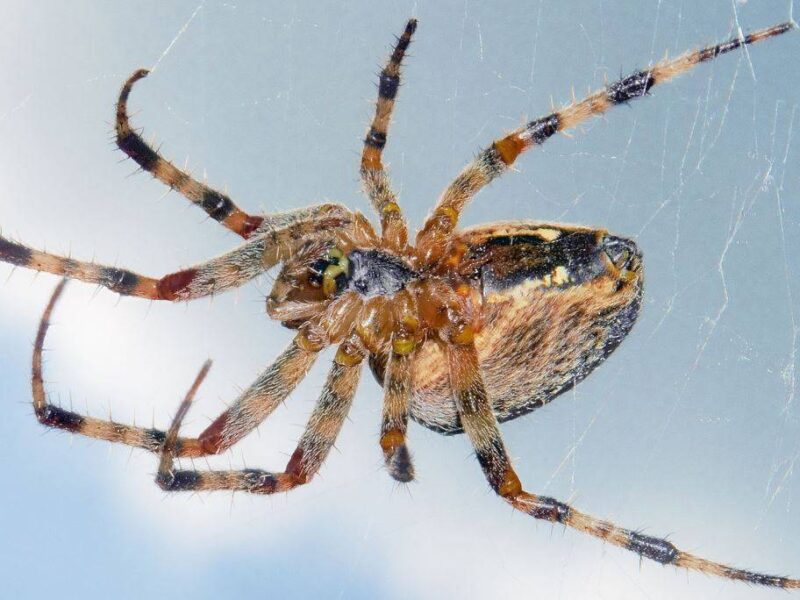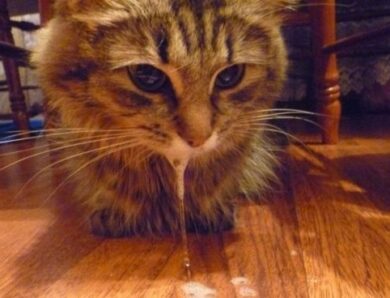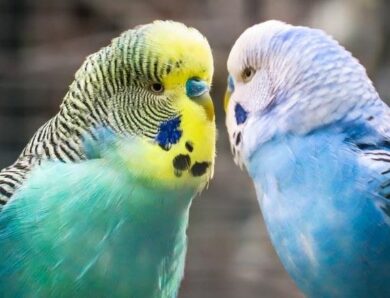
Interesting facts about the cross spider, its structure, appearance and level of poisonous bite
The spider-cross belongs to the family of roundworms. They live in almost every country, except the southern and northern latitudes. This species is the most common. There are in the world 2000 species of this spider, in Russia and Ukraine in general they live close 10 species. Most often this insect can be found in the Republic of Mordovia, Astrakhan, Smolensk and Rostov regions.
Favorite places of insects: fields, garden, shrubs near water bodies, groves, forests, in very rare cases, they live on the facades of walls and eaves of buildings. Mostly crusaders choose places with very high humidity.
The favorite place of the spider-cross became the crowns of trees in abandoned gardens or impassable forests. Identify, that this spider lives here it is possible on a wheel-shaped web. In view of the, that the web itself collapses under the influence of other insects, wind, trees, people, they are forced to dissolve it every two days and weave it again.
Appearance of an insect
Because of a kind of cross on the back, the spider got its name - the cross. The cross itself is formed of white and light brown spots. The abdomen is round, brown. Located on the body 4 a pair of legs, which are hypersensitive, and 4 money eyes, directed in different directions. The eyes of insects provide an opportunity to explore the world from all sides. An interesting detail: vision in spiders is blurred, they see only the outlines of objects or their shadows.
Females are almost twice as large as males. For comparison: the sizes of females vary within 17- 26 centimeters, and males - 10 — 11 cm. After certain periods, cross spiders shed and shed their chitinous cover. This period is characterized by active growth.
Particular activity of insects is observed at night, during the day they hide in their shelters. At night they weave a web. During the day, females can also become more active. It could be a fly hunt, butterflies. The unique creation freezes in one pose, which at first glance gives the impression, that he is dead, but it is a ruse for the victim.
The external structure of the cross spider
Spiders have 8 feet, with very sensitive olfactory organs. Their abdomen is rounded, resembles a droplet. There are spots on the abdomen, which form the shape of a cross. On the head 4 money eyes, which make it possible to provide a broad overview. Crusader spider is a poisonous hunter, therefore vision for him is a matter of life and death.
What wonderful insects eat
This species belongs to the carnivores. They need aphids for food, flies, mosquitoes, disgust. Spiders are waiting for their potential prey in the middle of the web, to which the signal thread is attached. As soon as the insect flies up to the web and gets into it, then trying to get out, they create the vibration of the web, so, the cross in the center receives a signal about a potential victim. In view of the, that on the legs of the cross spiders are the olfactory organs, then they hear the victim with their paws.
After receiving the signal, the insect approaches the victim and with the help of a bite injects poison into the body - chelicerae. Some crusaders eat the victim immediately, and others leave food in reserve. They wrap the victim in a web and hide from prying eyes in the leaves.
These insects eat a lot. They need the amount of food per day, equal in weight to their own. Almost always the cross spider is on duty, he hunts. He spends only a small amount of time resting per day, while the signal thread remains tied to the foot.
Cross spiders do not eat insects, which are too large for them or poisonous. These are thrown out of the web, breaking it off. Wasps and flies are dangerous for these creatures, which leave their larvae on the body of another animal. If such a fly or wasp leaves its larvae on the spider, then they themselves will begin to eat it, and evolve.
The main differences of the mysterious creation
These spiders belong to the species of dioecious animals. When mating took place, then the male dies, and the female is actively preparing the cocoon for future offspring. Most often, small egg spiders appear in autumn. At first, woven cocoon is on the back of the female, and then she carries him to a cozy and safe place. These can be cracks or small holes in the bark of the tree. New offspring emerge from the cocoon in the spring. Young individuals, ready for mating, they become by the end of summer, and then the old female dies.
Males at the beginning of their lives are actively weaving a web, to provide themselves with food. But as soon as the mating season comes, then they are engaged in nomadism, in search of females. They eat little, and this affects their difference in weight with the female.
When a spider finds a female, he carefully climbs into her web, and be sure to weave your own thread in case of retreat. Females may perceive a potential groom as their sacrifice and dinner. Then the male very gently twitches the web and as soon as it reacts and throws on the prey, he runs after his woven web.

Such games can last several minutes, until the female understands, that it was her fiancé who came. Further, pairing occurs, and here the male needs to be alert. Once the process has taken place, the female becomes a hunter again, and the male can become its victim. Therefore, he has to run quickly after mating.
How cross spiders reproduce
The pre-cooked cocoon is placed from 300 to 800 eggs. They have an interesting color of amber. Since the cocoon has a fairly thick wall, then future spiders are not afraid of frost, no water. Thus, the eggs are stored until spring, and with the onset of heat, young offspring are born. For some time young spiders sit in a cocoon. This is due to ignorance of the environment, and their fear of learning something new, but over time, they all leave the shelter and begin independent living.
In view of the, that the offspring in insects are very large, then there is a natural competition for the right to life. Some young spiders fall into the web of relatives, and they are eaten, and some cannot get food and also die. So, the farther the young spider goes from its cocoon, so in a better environment he will get and get more chances to survive and develop.
All movements of the considered individuals perform only due to their web, this is due to the fact, that their legs are very weak. They travel with the help of the accompanying wind. An interesting fact: on its web a cross spider can fly to 400 kilometers.
Crossbill bite for humans
The cross spider bites and releases its venom not only into insects, but also in humans. This often happens in the case of direct contact between the face and human hand. There are some rules to know, to avoid unpleasant contact with this venomous spider:
If you like to visit the forest, cottage and spend the night outdoors, then be careful to close the tent at night or use a mosquito net;
- Try to look at the place of sleep carefully before going to bed and in the morning, clothes and shoes for spiders and various insects;
- If you find yourself near a symmetrically woven web, try to get around it. Remember, that there are females on such, who are waiting for their victim;
- If you come to rest in an old and uninhabited house, or camp site, then inspect all cracks.
- Watch for the formation of cobwebs in the gardens in the country;
- If you encounter a crosshairs, then do not take it in your hands. And try to protect children from it.

If you are bitten by a crusader spider, then during 5 minutes such symptoms will appear:
- Headache;
- General weakness;
- Aching in the joints, painful sensations throughout the body;
- The bite site begins to itch and tingle;
- Subcutaneous hemorrhage may occur.
For humans, the bite of a venomous cross spider is not fatal, but first aid should not be neglected. Such manipulations should be performed:
- The bite site is washed with soap and water. To avoid further infection;
- If possible, then ice is applied to the bite site, or any other cold object;
- If you experience a headache or a slight fever, then you can take regular paracetamol;
- If you are allergic, then drink any antihistamines, to avoid possible exacerbations;
- In the case of a cross spider bite fell on a child, do not wait for the body's reaction, seek medical help.
The benefits of the cross spider for humans
Though, that spiders can let venom into the human body and pose a danger, their web has useful properties and can be used in various fields.
The cobweb has an excellent antibacterial effect, therefore it can be used to disinfect wounds.
In optical devices, where you need more accurate calculations, use the web of this spider.
Microbiologists have discovered and developed a unique air analyzer based on the crusader web. It is the web that captures all microparticles, which are in the air, and they determine the composition of the air.
Cross spiders are unique animals, which can be useful to mankind.




